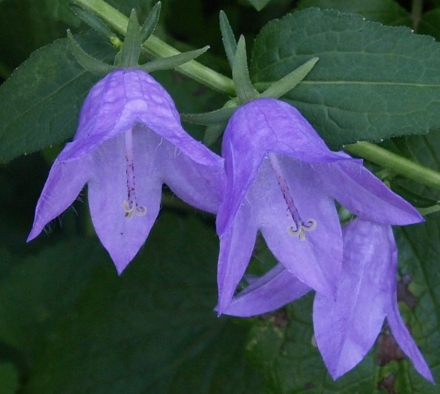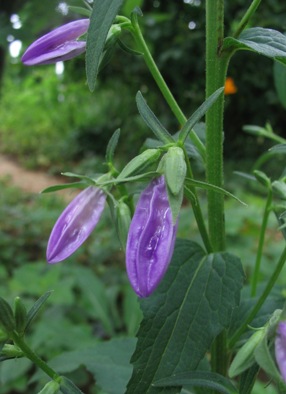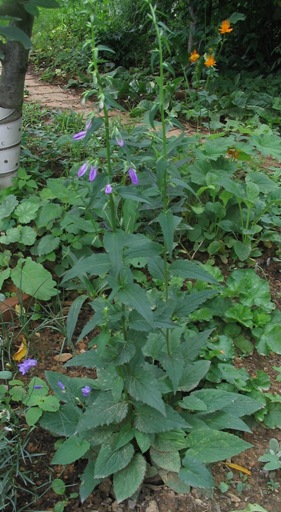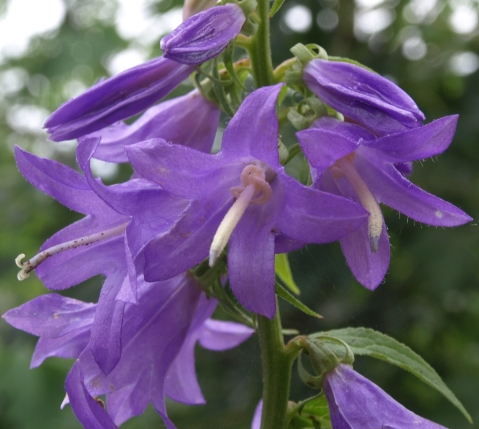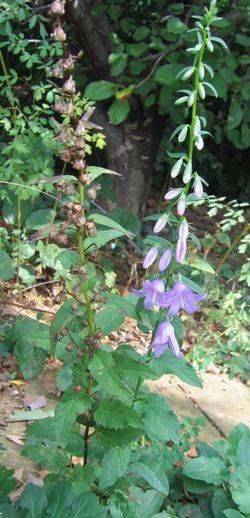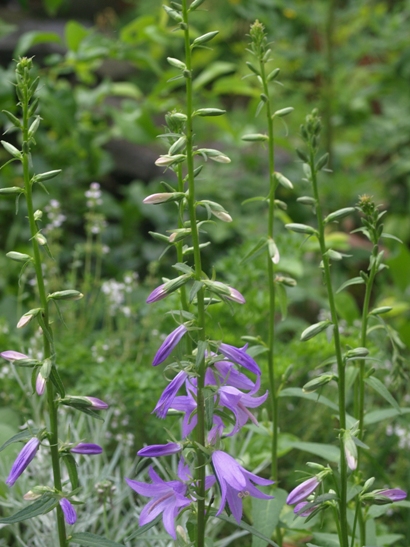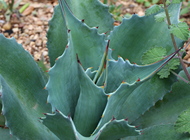 |
Campanula rapunculoides |
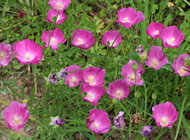 |
| Common name |
creeping bellflower; rampion bellflower |
| Family |
campanulaceae |
| Life cycle |
perennial (Z3-9) |
| Flowers |
blue (summer) |
| Size |
12-24" |
| Light |
sun-part shade |
A plant that comes with severe warnings, for it spreads agressively by its roots. I grew it from seed, and I didn't allow it to leave the pot in which I grew it: I planted it pot and all in the summer of its first season, where it overwintered and came back strong for its second year. It proceeded to bloom, and I thought it looked rather like the plant we had been growing as Adenophora lilifolia. It turns out that our Adenophora was in fact this campanula, as were several other "Adenophora" species I grew from seed derived from trades and society exchanges. Just for fun, I'm keeping a collection below of all those misidentified ones, each of which I had high hopes for until the truth became evident... As for the C. rapunculoides plant I actually grew on purpose: I allowed the plant pictured here to live in its pot for another year or so, but then discarded it – its ornamental properties are not worth the havoc it wreaks on garden areas it overruns...
One thing to note is that even though I believe all of these misidentified 'adenophoras' were in fact C. rapunculoides, they didn't all have the same habit in the garden. The specimen received as lilifolia was an aggressive root spreader - it didn't need to bloom to spread itself around. But most of the others don't seem to run by roots very much, instead multiplying by seed (which is easier to deal with, since none of these plants is very fast to flower, so they can be pulled up before they propagate themselves).
|
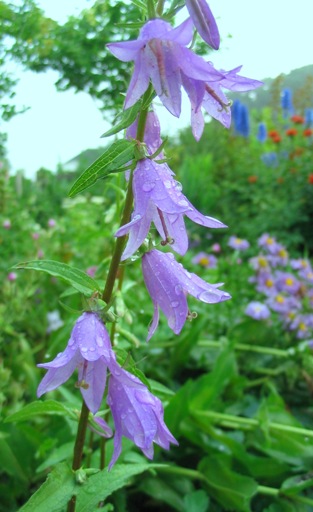
| | The plant we obtained as 'Adenophora lilifolia' that wasn't |
My original write-up of A. liliifolia: Pretty bellflowers on upright stalks. Too bad the plant we obtained (from a reputable online nursery, too) turned out to want to conquer the world by root. It was almost certainly the evil Campanula rapunculoides – which I have still not eradicated from the areas of the garden where it managed to get a foothold.
|
My original write-up of "Adenophora pereskiifolia": One of two new species of Adenophora we grew from seed a few years ago. Their basal foliage looked quite different from that of others in the genus in early spring, but by mid-summer the plants look similar to their peers. My attempt to ascertain, by examining the base of the style, that this is indeed an adenophora rather than a campanula failed, and the leaves look different from online photos of the species, so I'm pretty sure my plants are not what I think they are. They appear distinct from similar species in the way the white stamens spiral around the style. In any case, they have shown no invasive tendencies, which is always a relief with campanulas and their close relatives.
Post-scriptum: although this particular strain did not spread much by roots, it has proven a nuisance from self-seeding. Still trying to get rid of it in our bogside border.
|
My original write-up of A. polyantha: We've had A. lilifolia in our garden for a long time, and because we've come to understand all too well its wandering ways, I was hesitant to admit any of its cousins into our garden. However, I learned that there are many worthy, non-invasive species of ladybells, and so we've been trying a couple new ones. The flowers of this species look rather like the lily-leaved one.
|
My original write-up of A. khasiana: Many-branched perennial bearing spikes of large blue bellflowers, with a darker purple ring around the eyes. At least that's what they were supposed to look like.
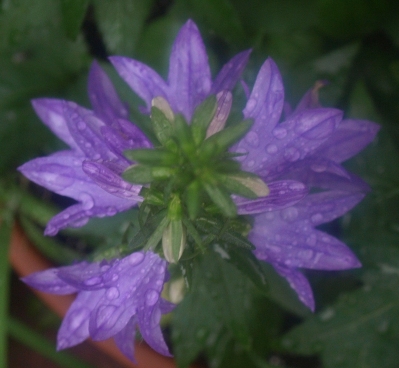
| | Flowers arranged nearly around the stem |
|
We left this plant behind in our Pennsylvania garden (and wish it well); we don't grow it in Houston. About my plant portraits
PlantLinks to other web pages about Campanula rapunculoides
Visitors to this page have left the following comments| Shelly King | Jun 19, 2015 | Thank you I do love this flower. Like so many it spreads.
|
| Lori Skulski | Jun 30, 2016 | Hi, Rob,
It's great that you discuss the almost complete mischaracterization of Adenophora species by the horticulture trade. Unfortunately, the fact that the trade has typically been selling the noxious weed, Campanula rapunculoides, in the guise of a variety of Adenophora species, has given the genus, Adenophora, an undeserved bad name.
On that note, your comments in the original write-ups continue to propagate the erroneous notion that Adenophora species are invasive. For example: "My original write-up of A. polyantha: We've had A. lilifolia in our garden for a long time, and because we've come to understand all too well its wandering ways, I was hesitant to admit any of its cousins into our garden."
I've been growing A. liliifolia in my garden for approaching 20 years now - it is completely non-invasive. It is tap-rooted and has never produced an offset. It has no "wandering ways".
While I realize you've left your old comments as some sort of a record, it would help to correct old, much-repeated misinformation about Adenophora species if you could perhaps edit out the erroneous statements that are based on misidentification.
By the way, I see you are active at All Things Plants (now National Gardening Association). (I had my fill there long ago and quit. However, I have helped to clean up the Adenophora entries at Dave's Garden.) At a glance, the entries at All Things Plants for A. lillifolia, stricta, potaninii, pereskiifolia, 'Amethyst', and khasiana all appear to be Campanula rapunculoides. The entry for A. bulleyana may also be wrong, as the flowers don't appear to be in the groups of 3 that are referenced in descriptions.
Aside from the specific request above re. your site, anything further you can do to clean up the Adenophora mess, and maybe someday restore the trampled reputation of the genus in the garden, would be much appreciated.
Lori
Hi Lori,
I appreciate your quest for eradicating botanical misinformation from the web - and will get around to some of your other suggestions as I find time. In this case, however, I think my page is quite clear in its content, and I doubt anybody will take it as a statement that Adenophora is invasive.
I haven't participated at All Things Plants since about a year ago (when I learned I would be leaving Pennsylvania and my gardening activities took a back seat). |
| Nell Lancaster | Oct 27, 2016 | More than 20 years ago, I planted 3 of what was listed as Adenophora liliifolia from Viette, back when they sold a huge variety of perennials. The soil here is heavy clay. The "ladybells" didn't run anywhere in the first six or seven years in the border, increasing only very modestly. Then there was a decade of almost total neglect, which they survived but didn't exploit: when I weeded that area during recovery five years ago, they were occupying just about the same ground as where they were originally planted, and took a season to begin blooming again after the removal of the fine grass that had infiltrated their sector.
Still thinking they were A. liliifolia (and occasionally wondering why the foliage looked nothing like lilies), I've welcomed their expansion over the last several seasons. Today, alerted by a notice in the LazyS online catalog that they've stopped selling "A.l." because of invasiveness, I googled around, and am very grateful for the info from both Lori and Rob. A first-ever rebloom stalk in full bloom today has allowed me to take apart the bloom.
Of course, what's here is definitely Campanula rapunculoides. I can only assume that it hasn't proven rampant because of the heavy soil and being ringed by neighbors that are strongly rooted and well estalished clumps: yucca, phlox, mature daylilies. The ID has given me the green light to remove and pitch all the increase at the outer edges. I'm not going to remove it entirely unless it suddenly takes off in new directions. There's been no spread from seed -- and I'm pretty sure there'd be some signs by now if it were likely to do so: I depend on and encourage a lot of self-seeding, so the soil between most plants is lightly mulched if at all. |
| Donna Pankratz | Jun 28, 2025 | I need to eradicate campanuls rapunculoides from my lawn. I have not found any
weed killer that effects it. I am not confident I can find this web page again so would appreciate if you know of something I can rid my yard of this invasive plant that you text me at 507 341 2191. |
I welcome comments about my web pages; feel free to use the form below to
leave feedback about this particular page. For the benefit of other visitors
to these pages, I will list any relevant comments you leave, and if
appropriate, I will update my page to correct mis-information. Faced with an
ever-increasing onslaught of spam, I'm forced to discard any comments including
html markups. Please submit your comment as plain text. If you have a
comment about the website as a whole, please leave it in my
guestbook. If you
have a question that needs a personal response, please
e-mail me.
Last modified:
July 02, 2016
Contact me
|


